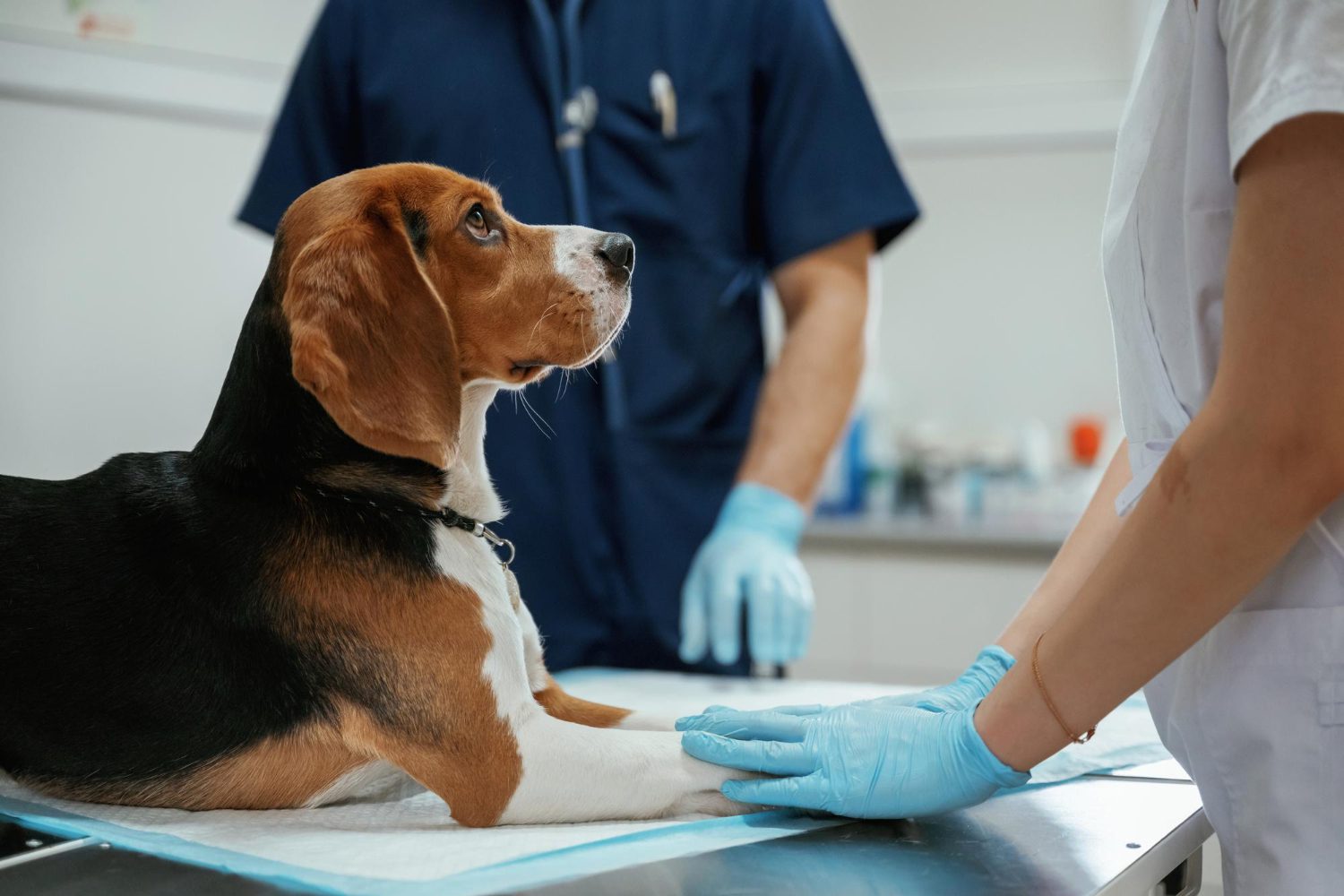Peritonitis in Dogs: Symptoms and Therapies

By Evelyn Harcourt
september 29, 2025 - 1 min read
The peritoneum is a serous membrane that lines the entire abdominal cavity. When it becomes inflamed, this is referred to as ‘peritonitis’. This inflammation may be septic (bacteria or other pathogens involved) or aseptic (free from contamination of microorganisms).
Canine peritonitis is a severe medical condition that makes dogs quickly and severely unwell. It causes intense abdominal pain and vomiting, and owners must seek emergency veterinary care.

What is Peritonitis in Dogs?
Peritonitis is an inflammation of the peritoneum, the abdominal cavity's lining. The peritoneum lubricates and physically supports the abdominal contents and also acts as a barrier to infection.
Peritonitis is thankfully quite rare, as it makes dogs very unwell. Sadly, there is a published mortality rate of 25% or more. Immediate veterinary intervention is required to try to stabilise the patient and nurse them back to full health.
Causes of Peritonitis
This condition can be primary (a rare spontaneous disease with no obvious trigger) or secondary (due to an issue like a leaking intestine or foreign body).
In veterinary medicine, secondary peritonitis is much more common than primary. The leak of something like bile, urine, or bowel contents can be the trigger.

Symptoms of Peritonitis in Dogs
The signs of peritonitis are not specific to the condition, meaning it is not always immediately obvious what is wrong with the pet. Some of the classic symptoms include:
- Acute and intense abdominal pain
- Lethargy and weakness
- Fever (though this is not always present)
- Food refusal or a reduced appetite
- Vomiting, with some patients being unable even to hold water down.
- Ileus (when the guts stop moving) and intestinal dilation (gas within the intestines).
- When this occurs, the abdomen may appear visibly bloated.
Early Warning Signs
Initially, owners may notice the dog is walking more stiffly or stretching a lot, and it is very reluctant to be touched. Touching the abdomen may lead to tremors or tensing, and some dogs may even growl or snap.
The dog will go off their food and wants to sleep more. Both vomiting and diarrhoea are commonly seen.
Advanced or Severe Symptoms
As peritonitis advances, the patient gets visibly more unwell. They can develop worrying signs such as a rapid heartbeat and panting, pale gums, and weakness.
Dogs can even go into shock, as their organs start to shut down. Their abdomen becomes intensely painful, and there is a rapid deterioration in their general condition.
How Vets Diagnose the Condition
Your vet will assess how your dog is acting and perform a thorough exam. The symptoms of canine peritonitis can mimic other conditions, such as pancreatitis, bile duct disease, Addisonian crisis, or a gut obstruction.
For this reason, more specific tests are needed to confirm the diagnosis. This can include blood tests, imaging of the abdomen, and analysing any free abdominal fluid.
A blood test will reveal a high white blood cell count. When there is urine in the abdomen, the blood urea nitrogen and creatinine are raised. High bilirubin is seen when there is a bile leak. Anaemia and acid-base imbalances may be seen in some cases.
Common Causes of Peritonitis
Though there is not always a clear-cut explanation as to why peritonitis occurs, sometimes there are identifiable causes.
Abdominal Injuries and Trauma
A direct injury to the abdomen, such as a stick injury (when a stick pierces the abdomen) or bite wounds, has the potential to introduce debris and bacteria into the peritoneum and to cause a large amount of localised inflammation.
Infections and Internal Diseases
Underlying medical issues like a ruptured pyometra (uterus infection), prostate abscess, or severe pancreatitis can also be to blame. In these cases, the dog is unwell for some time before their condition progresses to peritonitis.
Post-Surgical Complications
In some surgeries (like the removal of a foreign body from the intestine, or of a stone from the bladder), the internal surgical wound can break down.
If this leads to the contents of the intestines or the bladder leaking into the abdomen, this often results in peritonitis.
Therapies and Treatment Options
When it comes to treating peritonitis, we want the therapy to be aggressive and immediate.
Emergency Veterinary Care
If your dog is displaying symptoms of peritonitis, do not hesitate to call an emergency vet, so they can be seen right away. Having them seen quickly could be the deciding factor in whether they pull through or not.
Initially, the priority is in stabilising the patient. This can include oxygen, shock-rate intravenous fluids, and raising the body temperature. At the same time, your vet will be trying to establish the underlying cause of the peritonitis.
Medications and Antibiotics
Intravenous medicines like pain relief and antibiotics are typically started as soon as the pet presents to the vet clinic. Vets generally administer broad-spectrum antibiotics that are effective against a wide range of pathogens.
Corticosteroids or nonsteroidal anti-inflammatory drugs may be given to some patients, but this will depend on factors such as the dog’s blood pressure, hydration status, and the cause of its peritonitis.
Surgical Interventions
When the patient is stable, the surgeon can perform an exploratory laparotomy. This surgery should identify any leaking fluids within the abdomen and allow the peritoneal cavity to be thoroughly lavaged (washed with copious amounts of warm, sterile saline) and disinfected.
If any part of the gastrointestinal tract is damaged or necrotic, it may be repaired or removed. Drains are sometimes placed so fluid can continue to drain after the procedure.
In some cases, the surgical incision is not closed completely to allow abdominal fluid to drain onto sterile bandages, which are then changed regularly.
Supportive Care and Hospitalisation
It cannot be understated that these dogs are very sick. They will need to be kept in the hospital and closely monitored for quite a few days. They will need ongoing medicine to help manage their pain and nausea, and they may also benefit from assisted feeding.

Recovery and Prognosis
Each patient with peritonitis is an individual, and recovery time can vary quite a lot from one to another.
Factors Affecting Recovery
Your dog’s recovery will depend on a wide range of factors, including age, general health status, how quickly treatment began, and what caused its peritonitis. Seeking early vet care can greatly improve the prognosis.
Aftercare and Monitoring at Home
Your dog may be discharged a few days after surgery once it is eating without vomiting and no longer has a fever. It should also be able to walk and pass urine and stool. Over the next week or so, your dog will be seen at the vet clinic for check-ups to confirm that it is recovering well.
Once home, owners will be asked to monitor their dog’s energy levels and appetite and check its surgical wound for signs of infection. Dogs will be on oral antibiotics and pain relief for a week or two.
Preventing Peritonitis in Dogs
Not all cases of peritonitis are easily avoided. However, certain steps can be taken to reduce the risk. This includes:
- Sterilising your dog once they are old enough
- Preventing foreign body infections. This can mean keeping things like corn on the cobs, meat skewers, and bones out of reach, or using basket muzzles when outside, for dogs who constantly eat things they shouldn’t
- Not allowing your dog to play with sticks
- Keeping your dog on a lead when outside
- Avoiding pancreatitis by preventing obesity and not offering high-fat or greasy foods
- Maintaining a clean environment after any abdominal surgery and seeing your vet for all routine follow-ups

Discover More About Peritonitis in Dogs
Peritonitis is a serious and complex disease, but our staff is available to help if you have any questions or are concerned your pet could be unwell. Please contact us if you need any help with your dog.
Peritonitis in Dogs FAQs
Is Peritonitis in Dogs Fatal?
Sadly, peritonitis does have the potential to be fatal. Prognosis varies, and is reported as being anything from 25-75%. Canine peritonitis has the potential to have devastating consequences.
How Long Can a Dog Live With Peritonitis?
A dog may quickly pass away if peritonitis develops but is not treated. With intensive therapy, dogs often turn the corner in 3-5 days.
What Is the Cost of Treating Peritonitis in Dogs?
Treatment costs vary ,but this is inevitably a costly condition to manage. Patients usually require several days (or more) of intensive care in the clinic, as well as abdominal surgery. As a rough estimate, the cost can be around £2,500-£5,000.
Continue reading

Signs a Cat is in Pain and How to Recognise Them
Learn how to recognise pain in your cat and the subtle signs to look out for.
Read article
What to Do If Your Dog Eats Chocolate?
Learn what to do if your dog eats chocolate and the signs of toxicity to look out for.
Read article
Signs of Hypothermia in a Dog and How to Treat It
Learn the signs of dog hypothermia and how to treat it quickly and safely.
Read article